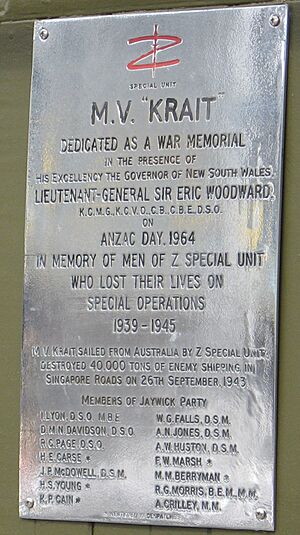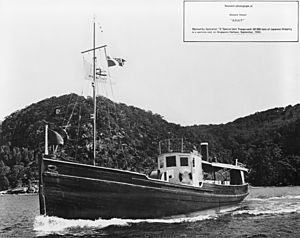Operation Jaywick facts for kids
Quick facts for kids Operation Jaywick |
|||||||
|---|---|---|---|---|---|---|---|
| Part of the Japanese occupation of Singapore during World War II | |||||||
 The MV Krait, used to infiltrate Singapore. |
|||||||
|
|||||||
| Belligerents | |||||||
| Z Special Unit | |||||||
| Commanders and leaders | |||||||
| N/A | |||||||
| Strength | |||||||
| N/A | 14 commandos and sailors 1 fishing boat |
||||||
| Casualties and losses | |||||||
| 3 ships sunk 3 ships damaged |
None | ||||||
Operation Jaywick was a secret mission during World War II. In September 1943, a small group of 14 commandos and sailors from the Allied Z Special Unit launched a daring raid. They attacked Japanese ships in Singapore Harbour, managing to sink or damage several vessels.
Contents
Planning the Secret Mission
In March 1942, a group called Special Operations Australia (SOA) was formed. This was a secret Allied military group. It was also known as the Inter-Allied Services Department (IASD). Many British officers who had escaped from Japanese-controlled Singapore helped start this group in Melbourne.
Forming Z Special Unit
In June 1942, a special commando team was created. It was called Z Special Unit, or Z Force. Most of its members came from the Australian Army and Royal Australian Navy.
The Daring Idea
In 1943, a British officer named Captain Ivan Lyon had a bold plan. He worked with an Australian civilian, Bill Reynolds. Their idea was to attack Japanese ships in Singapore Harbour. Commandos would travel in a boat disguised as an Asian fishing boat. Then, they would use special collapsible canoes, called folboats. They would attach limpet mines to Japanese ships.
Training for the Raid
Major Lyon and Captain Davidson organized the training for this mission. It took place at a hidden spot called 'Camp X' in New South Wales. Folboats were very important for training. Only a few suitable ones were found in Australia. These were bought from the builder, Walter Hoehn. A wooden canoe was also built for the camp.
The Krait Boat
Bill Reynolds owned a 21.3-metre (70 ft) Japanese fishing boat. It was called Kofuku Maru. He had used it to help people escape from Singapore. Lyon ordered the boat to be sent from India to Australia. When it arrived, he renamed it Krait. This name came from a small, very dangerous Asian snake.
The Attack on Singapore Harbour
In mid-1943, the Krait sailed from a training camp in New South Wales. It headed to Thursday Island. On board were 14 members of Z Special Unit. This included three British and eleven Australian personnel.
Crew Members
The team included:
- Major Ivan Lyon (the mission leader)
- Lieutenant Hubert Edward Carse (the captain of Krait)
- Lieutenant Donald Montague Noel Davidson
- Lieutenant Robert Charles Page
- Corporal Andrew Anthony Crilly
- Corporal R.G. Morris
- Leading Seaman Kevin Patrick Cain
- Leading Stoker James Patrick McDowell
- Leading Telegraphist Horace Stewart Young
- Able Seaman Walter Gordon Falls
- Able Seaman Mostyn Berryman
- Able Seaman Frederick Walter Lota Marsh
- Able Seaman Arthur Walter Jones
- Able Seaman Andrew William George Huston
Journey to Singapore
On August 13, 1943, Krait left Thursday Island. It stopped at Exmouth Gulf, Western Australia, for fuel and repairs. The repairs caused delays. Also, the special folboats ordered from England arrived late. They were faulty and needed many changes to work. This gave the crew little time to practice with them.
On September 2, 1943, Krait left Exmouth Gulf for Singapore. The team had to keep their disguise as a local fishing boat. The men dyed their skin brown to look more Asian. They were careful about what they threw overboard. They didn't want any European trash to make people suspicious.
The Raid Begins
After a smooth journey, Krait reached Singapore on September 24. That night, six men left the boat. They paddled 50 kilometres (31 mi) in their folboats (collapsible canoes). They set up a secret base in a cave on a small island near the harbour.
On the night of September 26, 1943, they paddled into the harbour. They secretly placed limpet mines on several Japanese ships. Then, they returned to their hiding spot.
After the Explosions
The limpet mines caused big explosions. Reports said that seven Japanese ships were sunk or badly damaged. This was over 39,000 tons of shipping. The commandos waited for the commotion to die down. Then, they returned to Krait, reaching it on October 2.
Their trip back to Australia was mostly calm. There was one tense moment in the Lombok Strait. A Japanese patrol boat came very close to Krait. But Krait was not stopped. On October 19, the ship and crew arrived safely back at Exmouth Gulf.
What Happened After the Raid

The Japanese authorities in Singapore were completely surprised by the raid. They never thought such an attack could come from Australia. They believed local people, perhaps Chinese fighters, were responsible.
The Double Tenth Incident
To find the attackers, the Japanese secret police started many arrests. They also treated people very harshly. Local Chinese and Malays, along with prisoners of war and European civilians, were targeted. This event became known as the Double Tenth incident. It was named after October 10, the day the mass arrests began.
Was the Raid Justified?
Some people have questioned if Operation Jaywick was worth it. This is because of the harsh treatment of the local people by the Japanese. The raid had limited military impact. The Allies never said they were responsible for the attack. They wanted to keep Krait a secret for future missions. So, the Japanese did not send many soldiers to defend against such attacks. Instead, they used their secret police to punish civilians.
Following Missions
Operation Jaywick was followed by Operation Rimau. In this later raid, no ships were likely sunk. Sadly, all the participants, including Ivan Lyon, were either killed or captured and executed.
Operation Jaywick in Popular Culture
The Australian writer Ronald McKie wrote a book about the operation in 1961. It was called "The Heroes". In 1989, a British/Australian TV miniseries was made based on McKie's book. The Heroes was directed by Donald Crombie. The cast included Paul Rhys as Ivan Lyon and Jason Donovan as 'Happy' Houston.
See also



